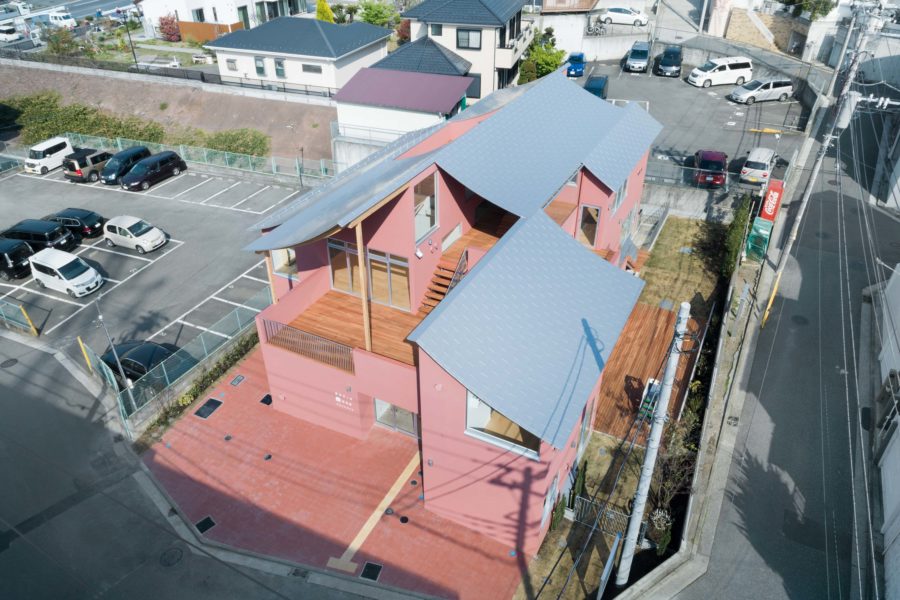アーティストである依頼主からは、一定のヴォリュームのある外的影響を受けないアトリエスペースと、小さくても見晴らしのよい居住スペースが求められた。敷地は東に海を望み、西には山が連なる高台にある。
計画は、四角いコンクリートの箱に二辺を残して鉄骨の箱が載るという構成である。
アトリエは二辺をトップライトとし、制作に必要な壁面長を確保している。トップライトはポリスチレンフォームで断熱し、軒天ガラリで換気を取り結露対策とした。
住宅部分東側は、海に向けての全面開口としている。張り出した窓台は窓拭き足場となると共に、近景をカットし、トリミングされた景色を獲得している。窓台は室内ではベンチとなり、下部にはダクト用防虫網を使用した通風開口を設けている。西側は、陳列レールを用いた細長い窓から山と空を望むことができる。
竣工が近づくにつれ「完成しきらない状態での引き渡し」という要望が何度か語られた。建築作品ではなくて、快適な制作と生活の場、環境を提供してほしいという意味であったと解釈した。
建築の設計は、依頼主の要求や敷地の条件を前提に空間をつくっていくわけだが、条件の整理分析の占める割合と個人の想像力が占める割合は、人によりさまざまである。条件の把握にも個人差があるであろうが、客観的事実を積み上げていくことを続ければほとんど必然的に建築が生まれるのではないかという期待をもっている。
依頼主がアーティストだから作品性の強い建築が敬遠されたというだけではなく、建築は本来、その場にふさわしい環境をつくることだと、今回改めて考えさせられた。(宮森洋一郎、『住宅特集2007年7月号掲載』より)
Mixed structure atelier and residence: Providing a comfortable space for creation and living
The client, an artist, requested a studio space of a specific volume unaffected by external environment, and a small living space with a captivating view. The site is situated on a hill, overlooking the sea to the east and mountains to the west.
The house consists of steel structured box placed on top of a square box made of concrete.
The house comprises a steel-structured box atop a square box made of concrete. To accommodate the necessary wall length for creative work, the studio is illuminated by two skylights on two sides. These skylights are insulated with polystyrene foam and ventilated at eaves to prevent condensation.
On the east side, facing the sea, an overhanging window frames the foreground, capturing a meticulously curated view. This window also doubles as a scaffold for window cleaning. Inside the house, the window sill functions as a bench and is equipped with a duct featuring an insect-proof net at the bottom for ventilation. On the west side, a long narrow window with a display rail provides a view of the mountains and sky.
As the construction neared completion, client repeatedly mentioned “handing over the house in an incomplete condition.” We interpreted this that the client wants a place where the client can engage in creative work, and his family can live a comfortable life rather than a piece of art created by an architect.
Architects design spaces based on client requirements and site context. However, the balance between organizing and analyzing conditions and individual imagination varies amongst architect. Despite differences in interpreting the context, I anticipate that by continually accumulating objective facts, architecture will almost inevitably emerge.
It is not only because the client, being an artist, avoided strongly designed architecture, this project prompted me to reconsider that, fundamentally, architecture is about creating an environment suited to the given context. (Yoichiro Miyamori)
【鞆の浦のアトリエ】
所在地:広島県福山市
用途:その他住宅
クライアント:個人
竣工:2007年
設計:宮森洋一郎建築設計室
担当:宮森洋一郎、印平将隆、石川 誠、奥野洋平
構造設計:SAK構造設計
機械設備:岡村設備設計
電気設備:連合設備設計
施工:井上建設
撮影:松岡満男
工事種別:新築
構造:RC造、S造
規模:地上3階
敷地面積:749.61m²
建築面積:106.09m²
延床面積:197.35m²
設計期間:2006.02-2006.07
施工期間:2006.08-2007.02
【Atelier in Tomonoura】
Location: Fukuyama-shi, Hiroshima, Japan
Principal use: Other houses
Client: Individual
Completion: 2007
Architects: Yoichiro Miyamori Architect & Associates
Design team: Yoichiro Miyamori, Masataka Inhira, Makoto Ishikawa, Yohei Okuno
Structure engineer: SAK Structural Design
Mechanical equipment: Okamura Equipment Design
Electrical equipment: Rengo Equipment Design
Contractor: Inoue Kensetsu
Photographs: Mitsuo Matsuoka
Construction type: New Building
Main structure: Reinforced Concrete construction, Steel construction
Building scale: 3 stories
Site area: 749.61m²
Building area: 106.09m²
Total floor area: 197.35m²
Design term: 2006.02-2006.07
Construction term: 2006.08-2007.02








